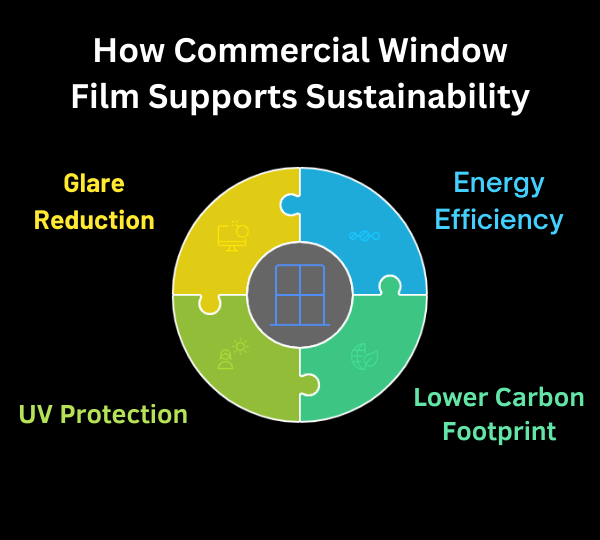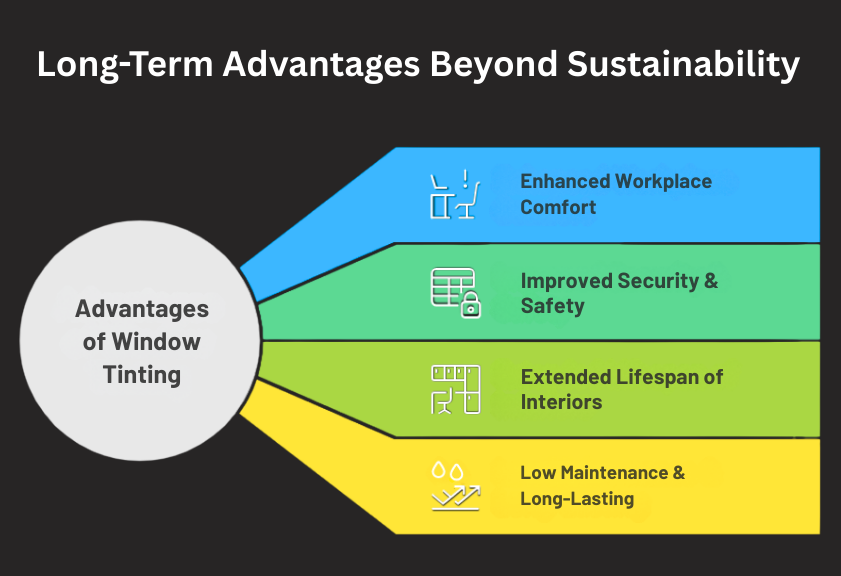In today’s world, sustainability is no longer just a buzzword, it has become an expectation. From reducing energy consumption to adopting eco-friendly policies, businesses are under increasing pressure to operate responsibly while keeping costs in check.
For many organizations, the challenge lies in finding practical solutions that align with both financial and environmental goals. One surprisingly effective option that has gained momentum is Commercial Window Film. Far more than just an aesthetic addition, this technology is helping companies of all sizes create healthier, more energy-efficient, and future-ready spaces.
The Push for Sustainability in Modern Businesses
Rising energy bills, growing customer awareness, and stricter environmental regulations are forcing businesses to reevaluate how they operate. Many companies are adopting green certifications like LEED and ENERGY STAR to demonstrate their commitment to eco-conscious practices. Yet, sustainable upgrades often come with hefty price tags, making them difficult for small to mid-sized businesses to adopt. This is where Privacy Window Film proves its value, a cost-effective, high-impact solution that can drastically improve energy performance without requiring expensive renovations.
What Is a Commercial Window Film?
At its core, commercial tinted window film is a thin, transparent or tinted layer applied directly to existing glass surfaces. It comes in various types, such as solar control films for heat reduction, decorative films for style and branding, and security films for added protection. Though simple in appearance, these films are designed with advanced technology to filter sunlight, block harmful UV rays, and regulate indoor temperatures. In essence, they transform ordinary glass into a performance-enhancing feature of the building.

How Commercial Window Film Supports Sustainability
1. Energy Efficiency
One of the primary reasons businesses install commercial window film is its ability to reduce heat gain inside buildings. By reflecting and absorbing a large portion of solar energy, window films lower indoor temperatures, reducing the workload on air-conditioning systems. Less reliance on HVAC not only lowers energy bills but also decreases wear and tear on equipment, extending its lifespan.
2. Lower Carbon Footprint
Because house window tint film reduces the amount of electricity required to maintain comfortable temperatures, it directly impacts a company’s carbon footprint. Businesses that adopt this technology consume less energy, thereby reducing greenhouse gas emissions. Over time, this contributes to broader sustainability goals and supports compliance with environmental standards.
3. UV Protection
Commercial window film can block up to 99% of harmful ultraviolet rays. This is particularly important for protecting indoor assets such as furniture, flooring, and merchandise, which can fade or discolor when exposed to constant sunlight. Beyond protecting interiors, UV protection also safeguards employees and customers by reducing exposure that could contribute to skin damage or long-term health issues.
4. Glare Reduction
Harsh glare from sunlight can make computer screens difficult to see, cause eye strain, and reduce productivity in office environments. By softening incoming light without completely blocking natural brightness, commercial window film improves visibility and comfort. Employees work more efficiently, and customers enjoy a more pleasant environment.

Long-Term Advantages Beyond Sustainability
1. Enhanced Workplace Comfort
By balancing indoor temperatures and minimizing glare, commercial office window tinting film creates a more comfortable environment year-round. Employees are less likely to suffer from hot spots near windows or cold drafts, leading to greater satisfaction and productivity.
2. Improved Security & Safety
Certain office glass window tint films add a protective layer that makes glass harder to break. In case of accidental impact or attempted break-ins, the film helps hold shattered pieces together, reducing the risk of injury and enhancing overall safety. For businesses dealing with sensitive data or valuable merchandise, this extra layer of protection can be invaluable.
3. Extended Lifespan of Interiors
UV rays are notorious for damaging interiors over time. By blocking these rays, Interior Window Tint film preserves the vibrancy of furniture, flooring, electronics, and décor. Businesses benefit from lower replacement costs and can maintain a professional, polished look for longer periods.
4. Low Maintenance & Long-Lasting
Unlike blinds or curtains that require frequent cleaning, replacement, or adjustments, indoor window tint film needs minimal upkeep. Once installed, it remains effective for years without fading or peeling, especially when applied by professionals using premium-grade materials. This durability makes it a long-term investment with lasting returns.
Final Thoughts
Sustainability in business is about more than ticking boxes on a corporate checklist, it’s about making smart, forward-looking choices that benefit both the environment and the bottom line. Commercial window film embodies this balance perfectly. It offers immediate savings, long-term environmental benefits, and practical advantages that improve safety, comfort, and productivity.
Ready to make your business more energy-efficient and sustainable? Trust All Spec Sun Control in Jacksonville to deliver premium commercial window film solutions built to last.
FAQs
1. How long does commercial window film last?
Ans: When installed properly, commercial window film can last 10–20 years and often comes with a warranty for added peace of mind.
2. Can commercial window film really lower energy costs?
Ans: Yes, it reduces heat gain and eases the load on HVAC systems, helping businesses see noticeable energy savings within the first year.
3. Does window film make interiors too dark?
Ans: No, modern films keep natural light flowing in while blocking heat and UV rays, so spaces stay bright and comfortable.
4. Is commercial window film a good investment for small businesses?
Ans: Definitely. It’s affordable upfront and saves money long-term through lower energy bills and reduced interior damage.

